The second-largest state both by area and population, Texas is known for its diverse landscape and ample nature. The state has 10 climate zones, ranging from high plains and forests to humid marine prairies. The state’s weather patterns are heavily influenced by the nearby Rocky Mountains, expansive flat prairies, and the Gulf of Mexico, which provides most of the state’s moisture.
No matter which corner of Texas you live in, though, you are at risk of natural disasters, such as hurricanes, heat waves, drought, and more. When these happen, it’s essential to be prepared.
So what are the most common natural disasters in Texas, how are they changing, and what can you do to prepare? Whether you’re planning a move to Dallas or are looking at apartments in Austin, read on for everything you need to know.
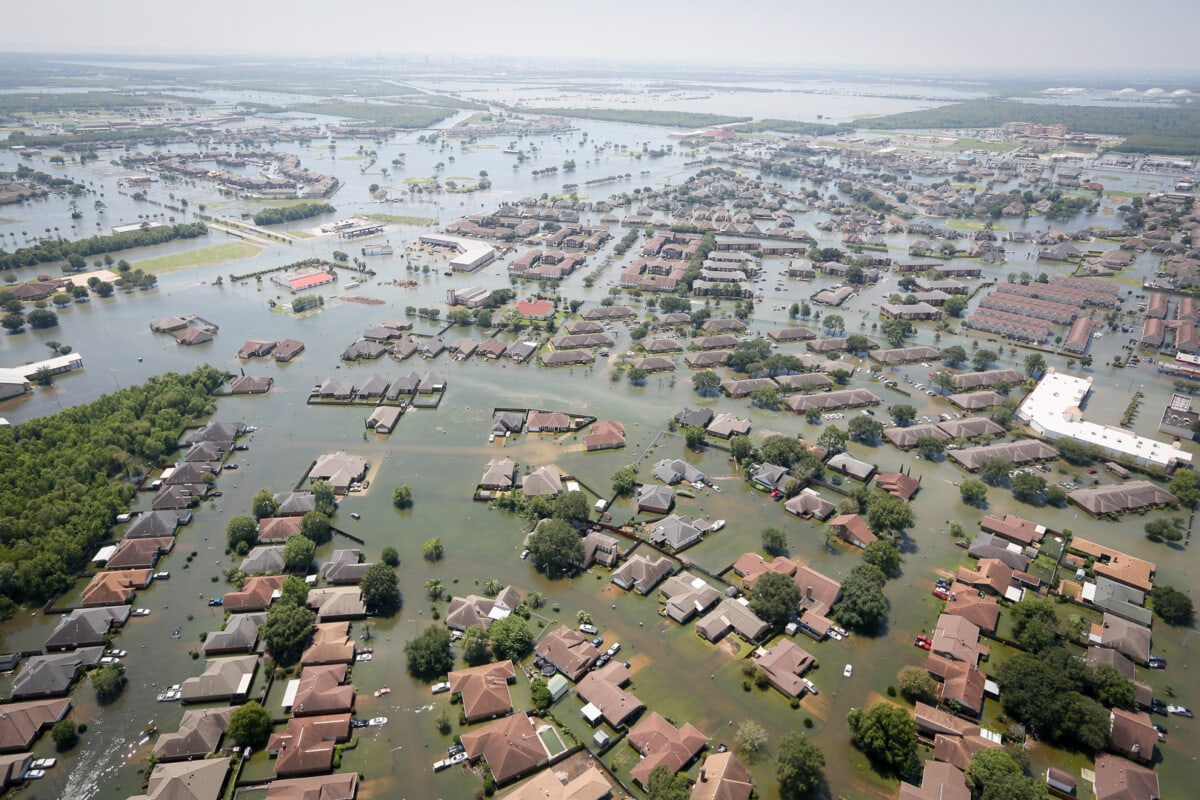
1. Texas flooding
Flooding is the most common and deadliest natural disaster in Texas, giving it the nickname “Flash Flood Alley.” The state is exceptionally prone to flooding due to its pattern of receiving intense, short bursts of rain from thunderstorms, tropical storms, and hurricanes.
Nearly every city in Texas is at risk of flooding. In central and west Texas, riverine floods are especially common along the state’s many rivers, and along the Gulf Coast, urban flooding can be catastrophic.
Texas’ largest cities are prone to flooding, especially Houston. Houston is highly susceptible due to its lack of drainage, minimal zoning codes, rapid growth, and widespread paving over floodplains. That, paired with coastal and stormwater flooding, makes it highly prone to catastrophic flooding, which was demonstrated during Hurricane Harvey.
How to prepare for flooding in Texas
In Texas, preparing for a flood is essential during the wet summer and early fall, especially during hurricane and monsoon season. Here are a few tips to help prepare for flooding in Texas:
- Familiarize yourself with flood risk maps for your area to see your potential risks. Most regions of Texas are in a flood zone, but especially the coast.
- Check your water supplier’s flood report.
- Purchase flood insurance if you’re in a high-risk zone and can afford it.
- Keep emergency supplies on hand, including non-perishable food, water, medications, and important documents.
- Elevate valuable items in flood-prone areas of your home, and install sandbags or barriers if necessary.
- Invest in flood sensors.
- Stay tuned to weather forecasts and alerts, and have a communication plan in place with your family.
- Understand your local flood and tsunami evacuation routes.
2. Texas heat waves
Hot, humid weather is common throughout Texas in the summer, especially in the western and central parts of the state. Temperatures here are often near or above 100 degrees Fahrenheit in summer, primarily in cities like El Paso and Rio Grande City. Heat waves can push temperatures far higher, though.
In the eastern part of the state and on the Gulf Coast, heat waves can become especially dangerous due to high humidity; temperatures can reach above 100 degrees Fahrenheit, which, when paired with high dew points, means the air can feel like 110 or more. This is especially dangerous in cities, which experience the urban heat island effect, raising temperatures by up to six degrees or more.
Most recently, a record-breaking heatwave in 2023 caused temperatures to climb to above 100 degrees for weeks on end, and up to 45 days in a row in cities like Austin. This heat wave lasted from June through August and caused exceptional drought conditions throughout the state. 2011 was the only other hotter year in state history.
Texas heat waves are predicted to get longer and more intense as climate change continues.
How to prepare for heat waves in Texas
Heat in Texas can be intense and deadly, especially during heat waves in the summer and early fall. All of Texas is prone to heat events, so it’s essential to be prepared. Here are a few ways to stay cool in extreme heat:
- Stay updated on forecasts and advisories to prepare for a heatwave.
- Prepare a meal plan that doesn’t involve cooking indoors.
- Stock up on lightweight, protective clothing.
- Close blinds, shades, and curtains.
- Stay hydrated before, during, and after a heat event, especially near the more humid coast.
- If your home is above 95 degrees, and you don’t have AC, don’t use a fan to cool yourself down.
- Install a generator in case the power goes out due to strained utility systems.
- Limit outdoor activities to the early morning and late evening.
- Switch from incandescent to LED light bulbs.
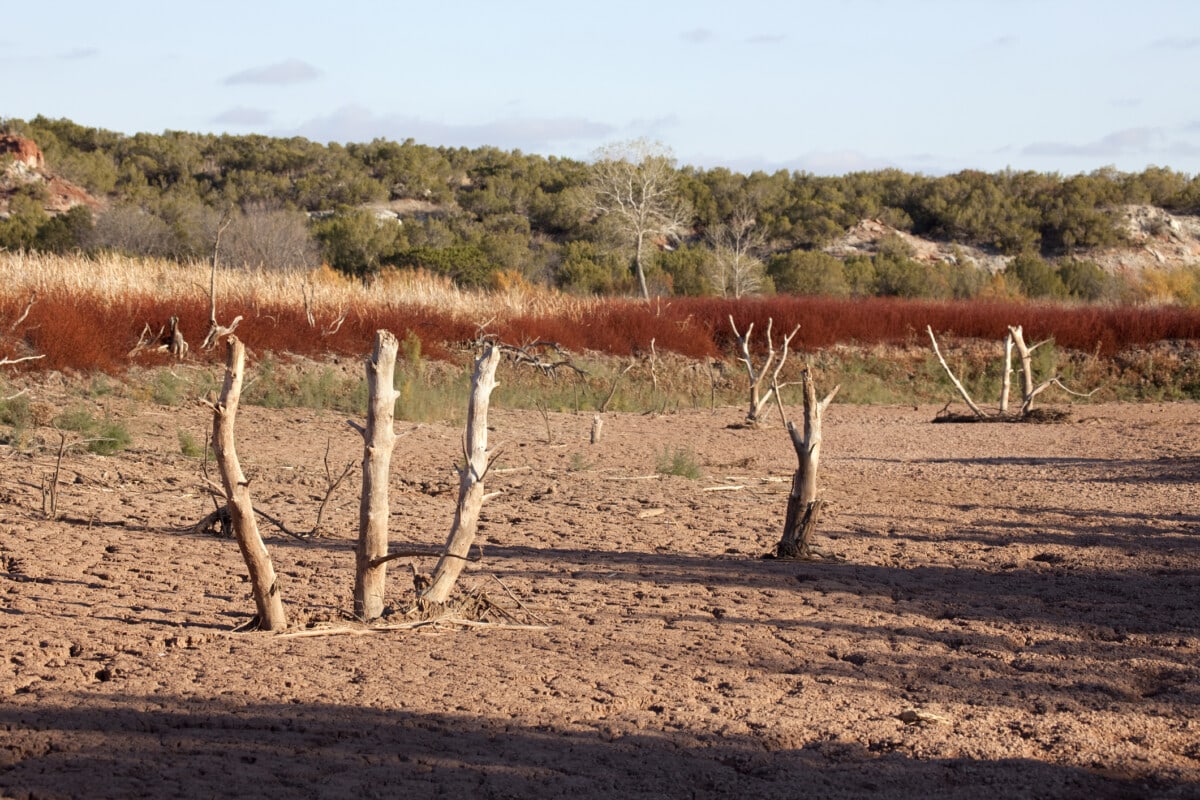
3. Texas drought
Drought is a major issue in Texas, especially during the dry winter. The state has experienced many droughts over the past 70 years. The longest and most impactful one was the 1950-57 drought, which continues to influence Texas water policy and demographics. More recently, the drought in 2011 was due to the driest year ever recorded in Texas, leading to 100% of the state experiencing drought conditions and 88% experiencing exceptional (D4) drought. Another series of droughts occurred in 2023 alongside a record heat wave.
The state averages around 30 inches of rainfall every year, with most coming in the fall, but regional amounts vary wildly – higher amounts on the coast, and lower in central and west Texas. This is changing, though. Generally, due to climate change, the state will receive more rain over shorter periods, leading to drier soil, longer droughts, and severe agricultural impacts.
Droughts can increase the frequency and severity of other disasters, such as forest fires and heat waves.
How to prepare for drought in Texas
Drought is a major concern throughout Texas, especially in the eastern and southern parts of the state. Unfortunately, droughts are becoming more frequent as climate change continues altering normal weather patterns, so it’s essential to be prepared. For example:
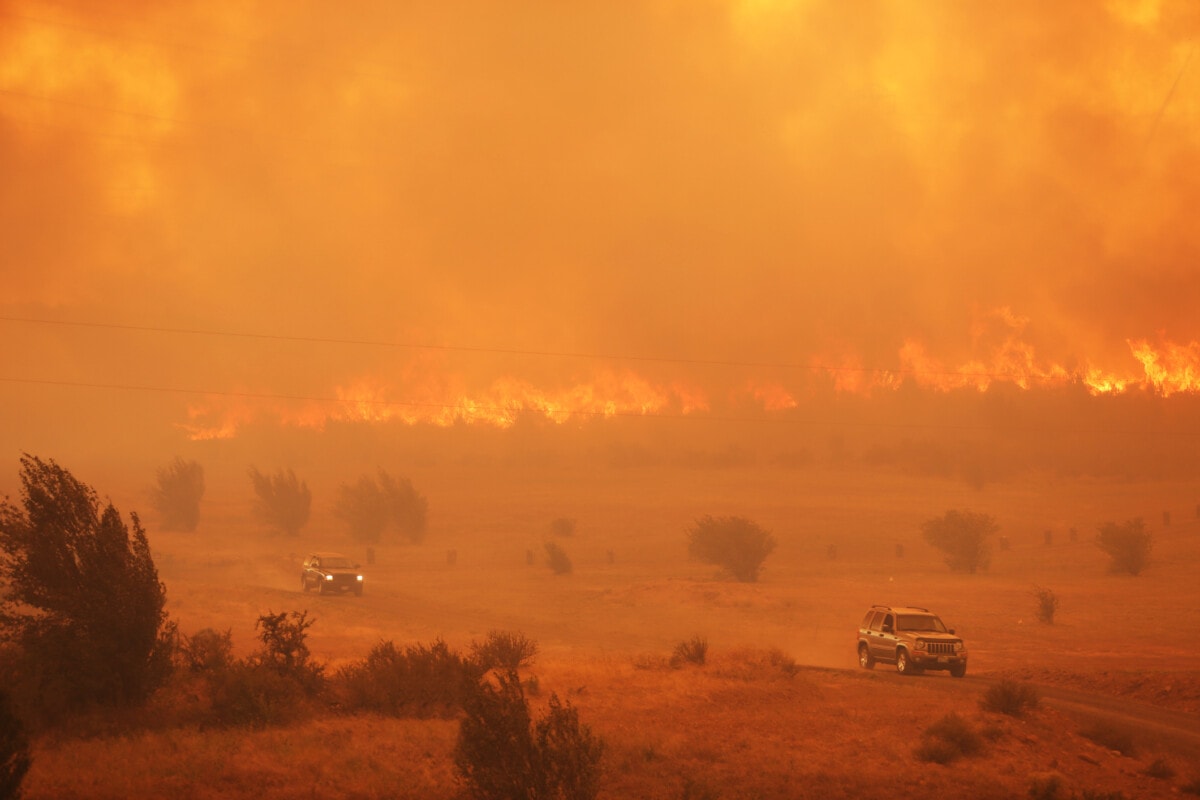
4. Texas wildfires
Wildfires are common in Texas and can happen anytime of the year, though they’re most common from February through April and August through October. Higher temperatures and longer droughts due to climate change have extended the fire season in Texas, especially in the central part of the state, where most fires happen.
Around 8.8 million (70%) of properties in Texas are at risk of being impacted by wildfires in the next 30 years, the highest number of properties at risk in the US. Other Southern states have a higher percentage of properties at risk, but fewer overall.
Recently, in the summer of 2023, due to extreme drought and persistent heat, Texas experienced hundreds of small wildfires, with as much as 85% of the state under burn bans.
Texas wildfires can worsen due to nearby tropical storms and hurricanes. For example, the Bastrop County Complex Fire, the most destructive wildfire in Texas history, was heavily influenced by strong winds from nearby Tropical Storm Lee.
How to prepare for wildfires in Texas
If you’re moving to Texas or already call the state home, preparing for wildfires is essential. Here are some tips to help:
- Create a defensible space around your property by removing flammable materials and trimming or removing dry vegetation.
- Develop an evacuation plan for your family and livestock, if applicable.
- Prepare for poor air quality by purchasing an air purifier and installing HEPA air filters on air conditioning units.
- Install interior and exterior sprinkler systems, if you have access to enough water and drought restrictions don’t prohibit it.
- Stay updated on fire weather forecasts and follow all fire restrictions. Texas A&M University offers an interactive map showing all active fires in the state.
- Ensure your insurance adequately covers fire damage, or understand the risks of going uninsured.
- Work with your community. This is the most successful way to mitigate fire risk in your neighborhood.
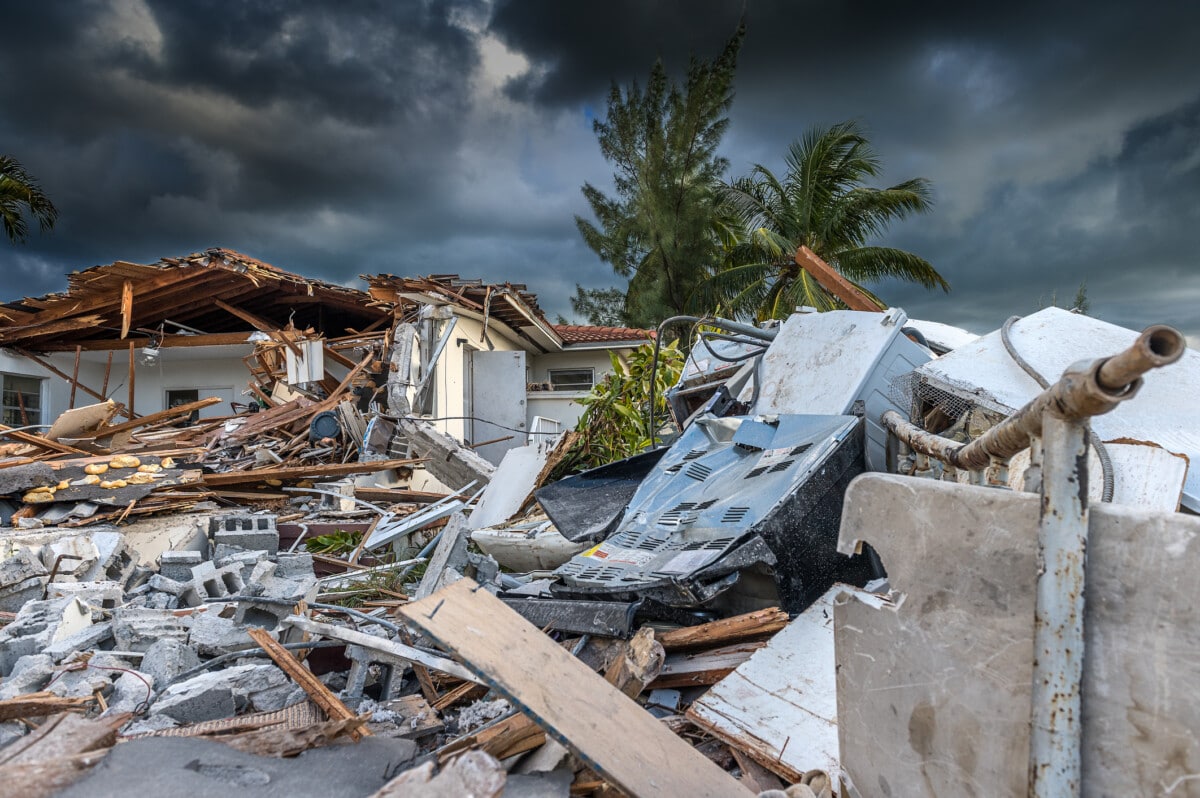
5. Texas tropical storms and hurricanes
Texas has received 64 hurricanes, second-most only to Florida. Every area of Texas’ coast is vulnerable, although the southern coast has historically seen the most direct landfalls. Hurricanes have the potential to cause catastrophic damage, including extensive flooding, wind damage, storm surges, utility disruptions, and more.
Texas generally receives hurricanes from the Gulf of Mexico, which is part of the Atlantic hurricane basin. The state has a six-month hurricane season that lasts from June through November, although most storms occur in August and September.
According to First Street Foundation, 59% of properties in Texas have some risk of wind damage over the next 30 years. However, specific cities have far greater risk. For example, in Houston, 100% of properties are at major risk. Hurricanes alone have cost homeowners, renters, governments, and insurance companies hundreds of billions of dollars.
Since 1957, there have been nine major hurricanes (Category 3 or higher) to hit Texas. Notable examples include Hurricane Rita in 2005, and Hurricane Harvey in 2017. Hurricane Harvey was especially destructive, causing widespread flooding, storm surges, wind damage, and historic rainfall to the Middle Texas Coast, including Houston. It’s the second-most expensive natural disaster in US history, behind Hurricane Katrina.
As climate change worsens and ocean temperatures heat up, hurricanes will get more powerful, damaging, and costly.
How to prepare for tropical storms and hurricanes in Texas
Texas is at risk of hurricanes, so it’s essential to be prepared. Here are a few tips to help:
- Stay updated on forecasts and follow all official evacuation orders.
- Familiarize yourself with the Texas evacuation zone map.
- Create a waterproof emergency kit, which should include water, nonperishable food, a can opener, medications, first aid supplies, important documents, and more.
- Keep a charged, durable communication device on hand.
- Strengthen your home from winds by decluttering drains and gutters, bringing in outside furniture, and trimming trees.
- Secure your doors and board windows, or install hurricane shutters. You can also hire a contractor to help prepare your home, but be aware of scams.
- Purchase flood insurance.
- Raise your home to protect it from storm surges and flood damage.
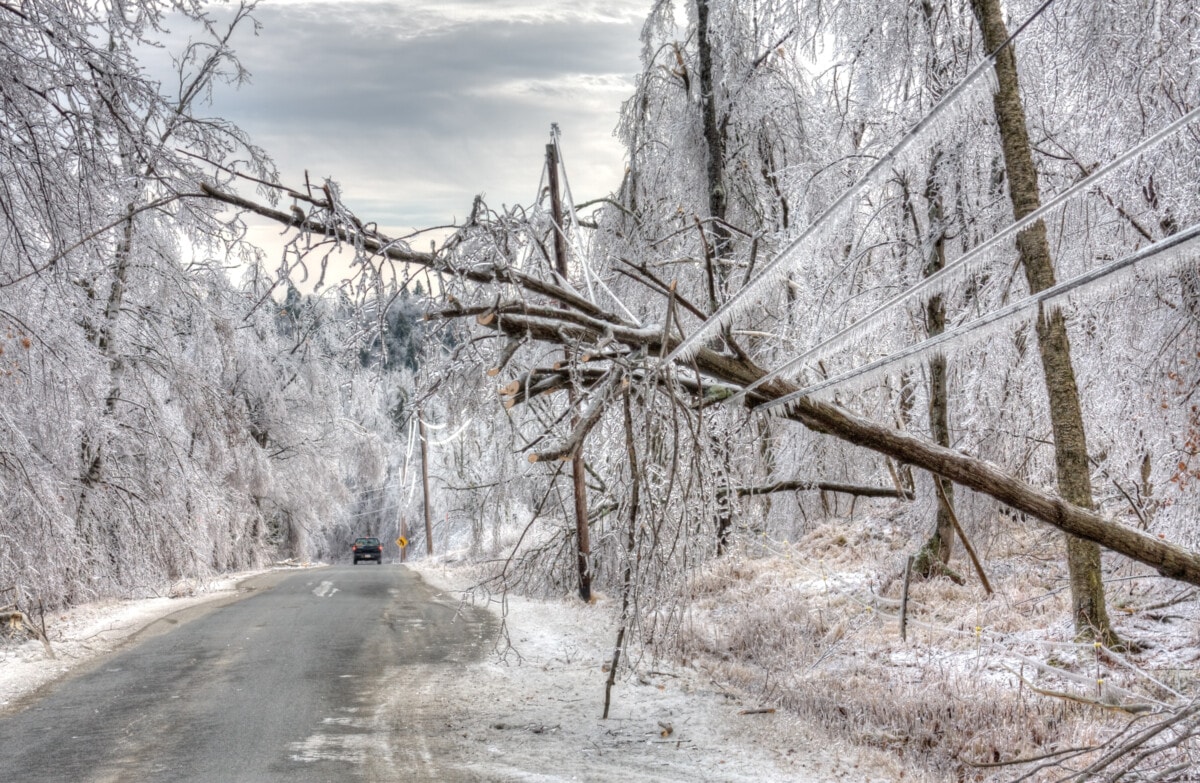
6. Texas winter storms
Even though Texas is in the warm and sunny Deep South, it can experience dangerous winter storms. Most winter weather involves cold temperatures, but sometimes they contain snow and even ice. Winter weather is dangerous in Texas because cities aren’t equipped to handle them.
Texas is unique in how its electric grid plays a role in natural disasters, especially winter weather. Most of the state’s electricity comes from natural gas and wind, but they aren’t winterized against freezing temperatures. Because the state uses a privately owned, self-contained power grid that is separate from the national grid, it’s much more prone to maintenance issues and blackouts. This can cause the system to fail even during periods of regular heavy use.
This was a major issue during the winter storms of February 2021, which caused much of the Texas power grid to fail due to extreme cold and ice, leaving over 10 million people without power. A similar event occurred in February 2023.
How to prepare for winter storms in Texas
Preparing for severe winter weather events is crucial to ensuring your safety and minimizing the impact on your home and family. Here are a few tips to help you prepare for winter storms:
- Winterize your home by inspecting your roof, clearing gutters, cleaning your chimney, insulating your attic, checking your heating system, and insulating your pipes. Storms can come quickly and last for days, so prepare as soon as you can.
- If winter weather includes an ice storm, take extra precautions, such as using snow-melting salt or pellets on your walkways and driveway, clearing your gutters, and covering trees to prevent them from falling.
- Install a generator outdoors to keep the power running in case of a blackout. You can also keep firewood or other heat sources.
- Update your emergency kit to include extra warmth.
- Equip your vehicle with chains, extra blankets, a shovel, and emergency supplies.
- Stay updated on weather forecasts and make sure you have a reliable method of communication.

Final thoughts on natural disasters in Texas
Texas is a warm, sunny state with many benefits. However, it’s also prone to numerous natural disasters, such as flooding, heat waves, hurricanes, and more.
If you’re considering moving to Texas or already call The Lone Star State home, make sure you’re prepared for natural disasters. Understanding your risks and adequately preparing are helpful to make the most out of living in Texas. The National Weather Service, FEMA, and the Texas state government offer experimental maps that show forecasted and possible risks in any given area, which can help you prepare.
Lastly, many natural disasters are worsened by climate change. So no matter how you prepare, reducing your carbon footprint and asking for systemic change are the best long-term solutions.
This article is for informational purposes only. Individual results may vary. This is not intended as a substitute for the services of a licensed and bonded home services or disaster prevention professional. Always seek expert advice and follow all official guidance before, during, and after a disaster.
- SEO Powered Content & PR Distribution. Get Amplified Today.
- PlatoData.Network Vertical Generative Ai. Empower Yourself. Access Here.
- PlatoAiStream. Web3 Intelligence. Knowledge Amplified. Access Here.
- PlatoESG. Carbon, CleanTech, Energy, Environment, Solar, Waste Management. Access Here.
- PlatoHealth. Biotech and Clinical Trials Intelligence. Access Here.
- Source: https://www.redfin.com/blog/natural-disasters-in-texas/
- :has
- :is
- :not
- :where
- $10 million
- $UP
- 1
- 10
- 100
- 110
- 2005
- 2011
- 2017
- 2023
- 30
- 70
- 8
- a
- above
- AC
- access
- active
- activities
- adequately
- advice
- afford
- After
- against
- Agricultural
- Aid
- AIR
- Air Conditioning
- Alerts
- All
- alone
- along
- alongside
- already
- also
- Although
- always
- amounts
- an
- and
- Another
- any
- anytime
- applicable
- April
- ARE
- AREA
- areas
- around
- article
- AS
- asking
- At
- AUGUST
- austin
- aware
- Bans
- barriers
- BE
- because
- become
- becoming
- been
- before
- behind
- being
- benefits
- BEST
- board
- both
- Bringing
- burn
- but
- by
- call
- CAN
- carbon
- case
- catastrophic
- Category
- Cause
- caused
- causing
- central
- chains
- change
- changing
- charged
- checking
- Cities
- City
- Cleaning
- Clearing
- Climate
- Climate change
- climb
- Clothing
- CNN
- Coast
- coastal
- Codes
- cold
- come
- comes
- coming
- Common
- Communication
- community
- Companies
- complex
- Concern
- conditions
- considering
- contain
- continues
- Contractor
- cooking
- Cool
- Corner
- Cost
- costly
- county
- covering
- covers
- crucial
- Dallas
- damage
- damaging
- Dangerous
- Days
- deep
- Demographics
- demonstrated
- destroyed
- device
- direct
- disaster
- disasters
- disruptions
- diverse
- do
- documents
- Doesn’t
- dollars
- Dont
- doors
- Drought
- dry
- due
- during
- Early
- eastern
- EDF
- Electric
- electricity
- emergency
- end
- enough
- ensuring
- EPA
- especially
- essential
- Even
- evening
- Event
- events
- EVER
- Every
- everything
- example
- examples
- exceptional
- exceptionally
- expansive
- experience
- experienced
- experiencing
- experimental
- expert
- extensive
- external
- extra
- extreme
- FAIL
- Fall
- Falling
- family
- fan
- far
- February
- few
- fewer
- filters
- Fire
- fires
- First
- flat
- flood
- florida
- follow
- food
- For
- forecasts
- Foundation
- Freezing
- Frequency
- frequent
- from
- GAS
- generally
- generator
- get
- given
- Giving
- GLO
- Goes
- going
- Governments
- greater
- Grid
- Growth
- guidance
- hand
- handle
- happen
- Have
- Health
- heat wave
- heavily
- heavy
- help
- helpful
- here
- High
- higher
- highest
- highly
- hire
- historically
- history
- Hit
- Home
- houston
- How
- However
- HTML
- HTTPS
- humid
- Hundreds
- hurricane
- ICE
- if
- Impact
- impacted
- impactful
- Impacts
- important
- in
- inches
- include
- includes
- Including
- Increase
- individual
- influence
- influenced
- Informational
- install
- installing
- insurance
- intended
- interior
- internal
- Investopedia
- involve
- involves
- island
- issue
- issues
- IT
- items
- ITS
- jpg
- june
- Keep
- kit
- Know
- known
- Lack
- landscape
- largest
- Last
- Late
- leading
- leaving
- Lee
- Licensed
- light
- lightweight
- like
- live
- local
- long-term
- longer
- looking
- lower
- maintenance
- major
- make
- MAKES
- many
- Maps
- Marine
- materials
- Matter
- max-width
- May..
- means
- medications
- method
- Mexico
- Middle
- million
- minimal
- minimizing
- Mitigate
- more
- morning
- most
- moving
- much
- National
- Natural
- Natural Gas
- Nature
- Near
- necessary
- Need
- next
- no
- normal
- notable
- November
- number
- numerous
- NY
- occur
- occurred
- ocean
- october
- of
- offer
- Offers
- official
- often
- on
- ONE
- only
- or
- orders
- Other
- out
- Outdoor
- outdoors
- outside
- over
- overall
- owned
- paired
- part
- parts
- passage
- past
- Pattern
- patterns
- Paving
- People
- percentage
- periods
- PHP
- pipes
- Place
- plan
- planning
- plato
- Plato Data Intelligence
- PlatoData
- plays
- points
- policy
- population
- possible
- potential
- power
- Power grid
- predicted
- Prepare
- prepared
- preparing
- prevent
- Prevention
- primarily
- professional
- prohibit
- properties
- property
- protect
- Protective
- provides
- purchasing
- purposes
- Push
- quickly
- RAIN
- raising
- ranging
- rapid
- reach
- Read
- receive
- received
- receives
- receiving
- recently
- record
- recorded
- Redfin
- regional
- regions
- regular
- reliable
- removing
- renters
- restrictions
- Results
- Risk
- risks
- rocky
- Role
- roof
- routes
- ROW
- running
- Safety
- salt
- scams
- Season
- second-largest
- see
- Seek
- seen
- sensors
- separate
- Series
- Services
- severe
- Short
- should
- show
- showing
- similar
- SIX
- small
- snow
- So
- soil
- Solutions
- some
- Soon
- Sources
- South
- Southern
- specific
- Star
- State
- States
- Storm
- storms
- street
- strong
- successful
- such
- summer
- sure
- Surges
- system
- systemic
- Systems
- Take
- texas
- that
- The
- The State
- Them
- There.
- These
- they
- this
- though?
- Through
- throughout
- tips
- to
- Trees
- Tsunami
- TX
- under
- understand
- understanding
- unfortunately
- unique
- units
- university
- updated
- us
- use
- uses
- using
- utility
- Valuable
- vary
- vehicle
- Vulnerable
- warm
- warmth
- was
- Water
- Wave
- waves
- Way..
- ways
- Weather
- weather patterns
- webp
- Weeks
- West
- Western
- What
- when
- whether
- which
- widespread
- will
- wind
- windows
- winds
- Winter
- with
- without
- worsen
- year
- years
- you
- Your
- yourself
- zephyrnet












